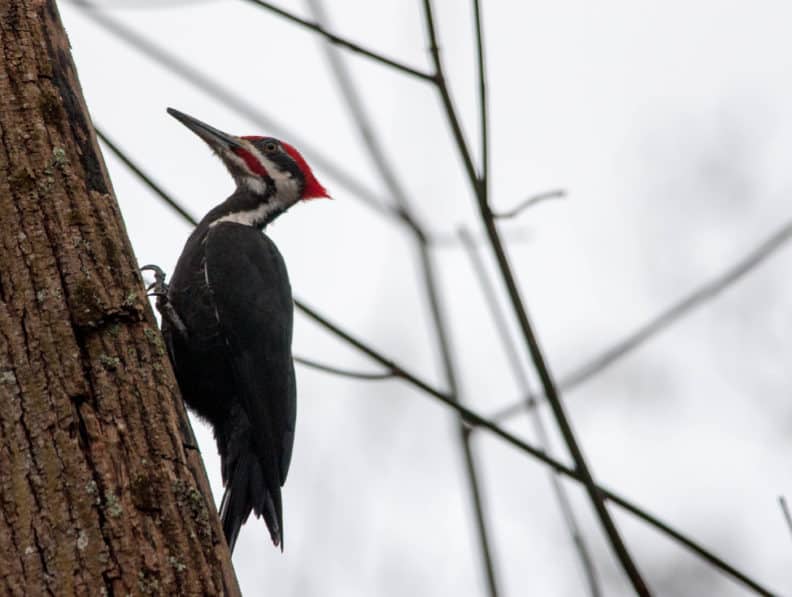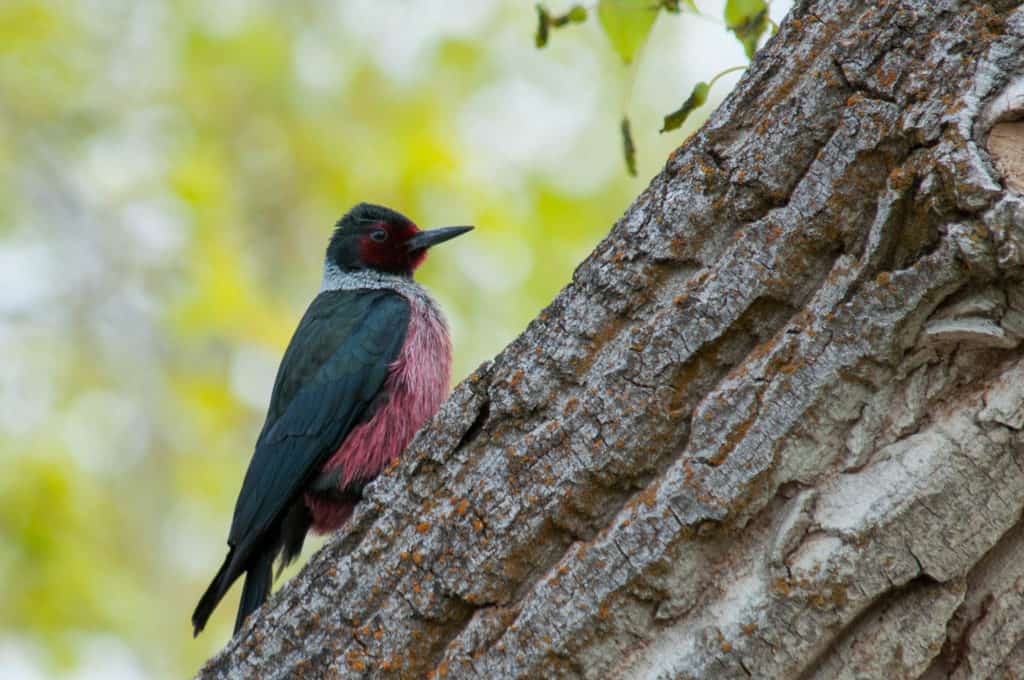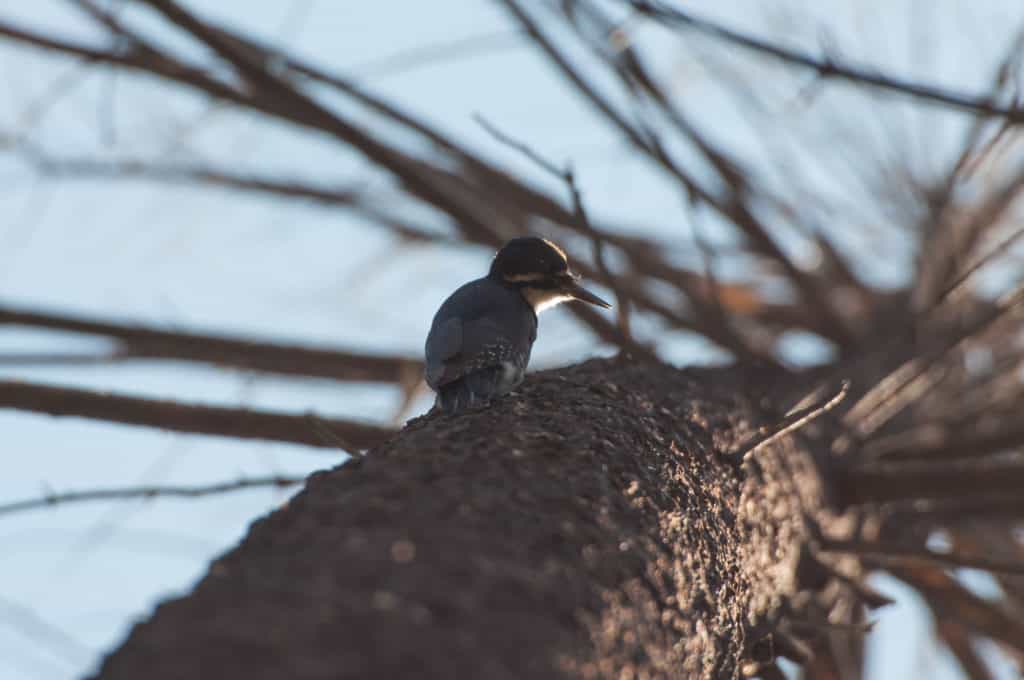
The Forest Engineers: Woodpeckers and their Role in Healthy Forests
This Naturalist Note was written by graduate student Brendan McGarry as part of the Fall Natural History Project in North Cascades Institute’s M.Ed. Residency coursework. You can view more student’s work here.
It was a morning like any other for an eight year-old on summer vacation. Sure, we were camping on the Olympic Peninsula, but that wasn’t going to stop me from playing with my action figures. I crept out of the family tent and got settled, my plastic menagerie piled at the base of a wind-twisted hemlock. But, before I could continue, a dark shape swept onto the tree trunk a mere foot overhead. Face to face with a Pileated Woodpecker (Hylatomus pileatus), whose name I would soon learn, I could do nothing but gawk. The bird simply went about its morning business, looking for food. Neither of us knew this was the moment that would propel me into a lifelong love of birds.
Over twenty years later, I was standing in a burned forest in Okanogan County, Washington, watching a Black-backed Woodpecker (Picoides arcticus) hack away at the charred bark of a lodgepole pine. My fellow Graduate M.Ed. students and I had been recently been tasked with deciding on a project topic for the Natural History of the North Cascades course, which my cohort was taking in our year-long residency. I realized that I was looking at my topic: the ecology of this woodpecker and the burned forests it resides in.
Straightforward ideas are wonderful, but intellectual freedom is even more fantastic. As my project became more fully formed, I continued to explore Black-backed Woodpeckers and burns. However, I also found myself paying homage to the 230 some woodpecker species of the world as vital to forest ecosystems. I came full circle, back to the inception of my passion for the natural world, and found woodpeckers worthy of high esteem.

But what exactly is a woodpecker anyway? The first part of the name gives us a clue: woodpeckers like wood, and therefore inhabit forests. Most spend their days are clinging to trunks, deriving their room and board from trees. In short, they’re built for an arboreal lifestyle.
Woodpeckers have fantastic adaptations for tree-life. First of all, they have strong feet with digits that form an “x,” giving them supreme grip on tree trunks as they search for food and homes. Their tail feathers are both a prop and a springboard for moving about the vertical world; long and strong, they keep woodpeckers balanced. All woodpecker bills are built for wholesale excavation, vital to their shelter, raising young, and staying nourished. Once a woodpecker exposes something it wants to eat, like a beetle grub or a carpenter ant, its barbed tongue, covered in sticky saliva, flicks out to pluck up tasty tidbits. Woodpecker tongues are so long they often anchor behind their skulls, and can extend many inches beyond their bill tips.
What does all this matter? In the process of their daily and yearly activities, woodpeckers play an important role in the forest. It may sound strange to say that birds that get no larger than a crow are vital to forest ecosystems in our region. But they are the main producers of tree cavities that other animal species call home.
We often don’t think of snags — dead standing trees — as important, but to a woodpecker they a vital place to find food and shelter. Without woodpeckers carving out cavities, birds like Spotted Owls (Strix occidentalis) would have far fewer places to nest, and one of their favorite foods, Northern flying squirrels (Glaucomys sabrinus), wouldn’t have safe places to hide. While excavating, woodpeckers also spread decaying organisms like fungus through the forest. In doing this, they play a role in natural decay, speeding up the processes that provide them and a host of other species with homes. Take a look around your local patch of trees and I guarantee you’ll find some evidence of woodpeckers.

Exploring the life of of the Black-backed Woodpecker broke open a whole new seam of personal admiration for woodpeckers in general. Birds and nature are worth our devotion and stewardship, simply for the fact that they are indescribably beautiful in form. But, the more we delve into any topic of natural history, the more we realize that everything is interconnected. Without my woodpecker encounter at eight, I wouldn’t be attempting to make the world a better place by sharing my passion for birds and nature. Without that woodpecker, and many others, the world wouldn’t be quite the place that I hold in such esteem.
Brendan McGarry: Blog ~ Photography Portfolio


Great blog! Though it seems obvious to me now, I wasn’t aware of the role woodpeckers play in creating snags/helping to transport decomposers. Thanks for teaching me something new!